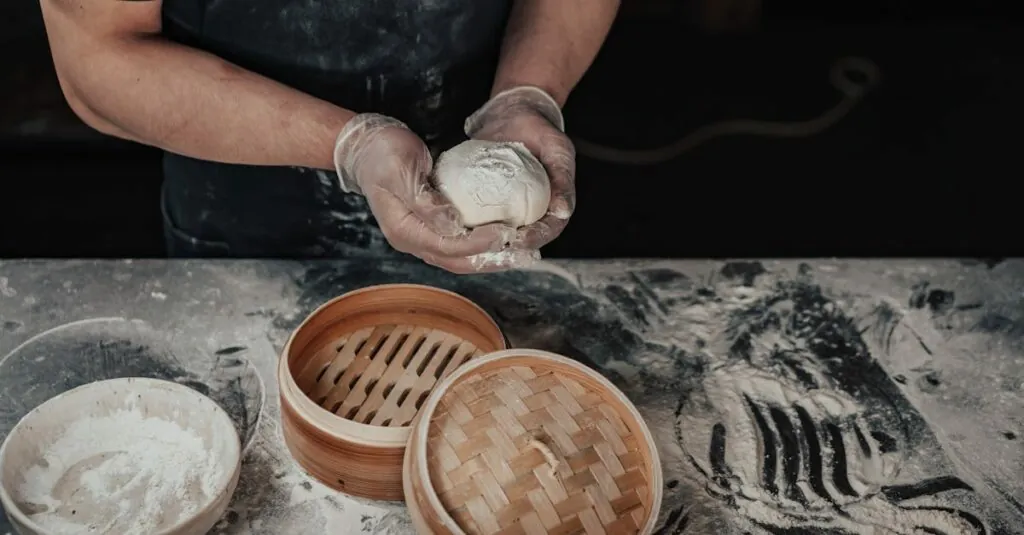Table of Contents
ToggleChinese cooking techniques are a culinary treasure trove waiting to be explored. From the sizzling sounds of stir-frying to the delicate artistry of steaming, these methods have been perfected over centuries, turning humble ingredients into mouthwatering masterpieces. If you think cooking is just about following a recipe, think again! It’s a dance of flavors, textures, and techniques that can transform any kitchen into a bustling Beijing street market.
Overview Of Chinese Cooking Techniques
Chinese cooking techniques showcase a variety of methods that enhance flavors and textures. Stir-frying stands out as one of the most popular techniques. It involves cooking food quickly over high heat in a wok with minimal oil. This method preserves the nutrients and colors of vegetables while imparting a distinctive smokiness.
Steaming is another fundamental technique. This method retains the natural flavors of ingredients while keeping them moist. Bamboo steamers or metal steaming baskets are common tools used in this process.
Braising combines both dry and moist cooking methods. In braising, food is first browned in oil and then simmered in a flavorful liquid. This technique yields tender results, especially for tougher cuts of meat.
Deep-frying introduces a crispy texture to dishes. Foods such as spring rolls and crispy chicken benefit from this technique. A hot oil bath ensures even cooking and a golden appearance.
A unique method, red cooking, involves simmering foods in a mixture of soy sauce, sugar, and aromatic spices. This technique enriches the dish with a deep, complex flavor.
Fermentation plays a vital role in enhancing the taste of various ingredients. This process generates umami flavors, prominent in items such as soy sauce and pickled vegetables.
Baking is increasingly prominent, especially in regions like Guangdong. Ingredients like mooncakes exemplify this technique. The process blends traditional and contemporary culinary practices.
Each technique contributes to the intricate tapestry of Chinese cuisine. Understanding these methods allows for crafting authentic dishes that reflect the culinary heritage. Chefs employ them to create unique flavors that transport diners to bustling markets in China.
Stir-Frying Techniques
Stir-frying stands as a fundamental technique in Chinese cooking, known for its speed and ability to enhance the natural flavors of ingredients. Mastery of this method relies on skillful execution and the right tools.
Essential Tools for Stir-Frying
A wok is crucial for effective stir-frying, allowing heat to distribute evenly and enabling quick cooking. A spatula designed for high-heat cooking helps in tossing and mixing ingredients efficiently. High-quality knives are needed for precise chopping, while a reliable cutting board provides a stable surface. Using a lid is helpful for steaming ingredients during the cooking process. Heat sources also play a significant role; gas flames are preferred for their intense heat production.
Key Ingredients for Successful Stir-Frying
Fresh vegetables, such as bok choy and bell peppers, contribute vibrant colors and textures. Protein sources like chicken, beef, or tofu offer flavor and substance. Soy sauce or oyster sauce provides rich umami, enhancing the overall dish. Aromatics such as garlic and ginger add depth. Incorporating oil with a high smoke point ensures a perfect sear without burning. Additionally, sliced green onions or sesame seeds can finish a dish, adding a pop of flavor and garnish.
Steaming Methods
Steaming forms an essential technique in Chinese cooking, enhancing the natural flavors of ingredients while preserving their nutrients. This method relies on steam generated from boiling water, allowing food to cook evenly without direct contact with water.
Benefits of Steaming
Steaming offers numerous health benefits. It retains vitamins and minerals that boiling often washes away. Fat content remains low as this method requires little to no oil, making steamed dishes a healthier choice. Moreover, steaming enhances natural flavors, avoiding the need for excessive seasoning. This technique also ensures a tender texture in foods, particularly in fish and vegetables, leading to appealing meals that satisfy nutritional needs.
Popular Steamed Dishes
Numerous dishes highlight steaming in Chinese cuisine. Dim sum showcases bite-sized dumplings filled with meats, seafood, or vegetables, all steamed to perfection. Shu Mai features thin wrappers filled with pork and shrimp, offering a delicate flavor profile. Another popular dish is steamed buns, often filled with savory pork or sweet red bean paste, enjoyed at any meal. Vegetable buns specifically target vegetarian diets, providing a healthy option. Egg custard represents a simple yet delicious steamed dish, combining eggs and broth to create a smooth texture.
Braising and Red-Cooking
Braising is a cherished technique in Chinese cooking, combining both dry and moist heat to achieve tender and flavorful dishes. This method often involves cooking meat or vegetables in a tightly covered pot for an extended period. The slow cooking process allows the ingredients to absorb the seasoned cooking liquid, resulting in rich, complex flavors.
The Art of Braising in Chinese Cuisine
Braising stands out for its ability to transform tough cuts of meat into tender bites. This process often begins with searing ingredients in hot oil. Following the searing, a flavorful liquid, such as broth or wine, is added to the pot along with aromatics. Once combined, the dish simmers gently on low heat. Techniques like double-braising can elevate dishes even further, creating layered flavors that showcase the chef’s skill.
Common Ingredients in Braising
A variety of ingredients play pivotal roles in braising. Soy sauce provides a savory base, while rice wine enhances depth of flavor. Star anise and ginger infuse aromatic notes, and garlic contributes an extra layer of taste. Common meats used include pork belly, beef shank, and chicken wings. Vegetables, such as carrots and radishes, sometimes join the mix, absorbing the flavorful broth. The combination of these ingredients leads to hearty and satisfying meals, showcasing the essence of Chinese cuisine.
Deep-Frying Techniques
Deep-frying is a popular method in Chinese cuisine, producing crispy delights that excite the palate. This technique involves immersing food in hot oil, resulting in a satisfying crunch and a delicious aroma.
Types of Oils for Deep-Frying
Selecting the right oil is crucial for achieving perfect deep-fried dishes. Common options include peanut oil, with its high smoke point and nutty flavor, and vegetable oil, known for its neutral taste and cost-effectiveness. Canola oil provides a good balance between flavor and frying temperature. Sesame oil, while rich and aromatic, is typically used in smaller quantities due to its strong taste. Each oil contributes unique properties, enhancing flavor and texture.
Creating the Perfect Batter
Crafting the ideal batter elevates deep-frying results. A typical batter consists of flour, cornstarch, and cold water, resulting in light and crispy coatings. Adding egg enhances richness and binds ingredients. Incorporating baking powder creates extra fluffiness, helping the batter puff during frying. Seasoning with salt, pepper, or spices can amplify flavors, making it customized for various ingredients. Achieving the right consistency is vital; it should be thick enough to adhere yet fluid enough to evenly coat food.
Chinese cooking techniques showcase a remarkable blend of tradition and innovation. Each method brings its own unique flavor and texture to the table, transforming everyday ingredients into extraordinary dishes. From the fast-paced stir-frying that captures the essence of freshness to the gentle steaming that preserves health benefits, these techniques highlight the artistry behind Chinese cuisine.
As chefs continue to explore and adapt these methods, the culinary landscape evolves while honoring its rich heritage. Embracing these techniques not only enhances cooking skills but also deepens the appreciation for the vibrant culture that shapes this beloved cuisine. Whether one is a novice or an experienced cook, diving into Chinese cooking offers a delicious journey of discovery and creativity.




